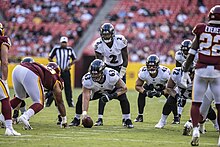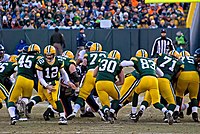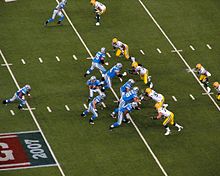Fullback (gridiron football)
This article has multiple issues. Please help improve it or discuss these issues on the talk page. (Learn how and when to remove these messages)
|

A fullback (FB) is a position in the offensive backfield in gridiron football and is one of the two running back positions along with the halfback. Fullbacks are typically larger than halfbacks, and, in most offensive schemes, the fullback's duties are split among power running, pass catching, and blocking for both the quarterback and the other running back.[1]
Many great runners in the history of American football have been fullbacks, including Jim Brown, Marion Motley, Bronko Nagurski, Jim Taylor, Franco Harris, Larry Csonka, John Riggins, Christian Okoye, and Levi Jackson. However, many of these runners would retroactively be labeled as halfbacks, due to their position as the primary ball carrier; they were primarily listed as fullbacks due to their size and did not often perform the run blocking duties expected of modern fullbacks. Examples of players who have excelled at the hybrid running–blocking–pass catching role include Vonta Leach, Mike Alstott, William Henderson, Daryl Johnston, Kyle Juszczyk, John Kuhn, Le'Ron McClain, Lorenzo Neal, Marcel Reece, Larry Centers and Tom Rathman.
A decline in the usage of fullbacks, particularly at the professional level, occurred during the late 2000s to mid 2010s. Moreover, the term fullback is increasingly used to refer to specifically running backs focused on blocking, much like how the original quarterback is the blocking back. This is likely due to teams beginning to focus more on passing, as well as the increased popularity of personnel groupings and formations that omit the position. As a result, the role of fullbacks as ball-carriers in the run game has decreased, and most fullbacks only run the ball in rare instances, typically in short-yardage situations. The decline of the position peaked during the mid 2010s, where many NFL teams began phasing the position out of their offenses entirely. However, following the 2017 NFL season the position saw a gradual resurgence and evolution as teams began using the position again. By the early 2020s, following the position's evolution into a role more similar to a tight end rather than a running back. Even NFL teams who do not carry an official fullback on their roster still use the position in their offense, usually having a main player who acts as their primary fullback or through a rotation of players at the position.
Role
[edit]The role of a fullback in the modern NFL varies from team to team. A number of teams have expanded the fullback's role in the passing game, with fullbacks Kyle Juszczyk and Alec Ingold both being examples of fullbacks who have frequently contributed as receivers to their teams. There is also a number of teams who focus on the blocking aspect of the position and employ larger players at the position like converted defensive or offensive linemen. Patrick Ricard and Scott Matlock are examples of fullbacks who have also played on the defensive line in addition to their roles as fullbacks and are used primarily as lead blockers. Certain contemporary fullbacks or players frequently used as fullbacks are also important special teams players. Reggie Gilliam, CJ Ham, Derek Watt, and hybrid linebacker/fullback Nick Bellore are all examples of contemporary fullbacks who have been standout special teams contributors throughout their careers.
For teams that do not carry a "true" fullback on their roster, there are often two approaches that teams take in regards to the usage of fullbacks in contemporary football. The first approach uses the fullback primarily as a blocker. When teams that take the approach use an alignment featuring a fullback they are using the position as a blocker and will accordingly use a player who is a skilled blocker. Typically these teams will use a blocking tight end in this role, though offensive and defensive lineman and linebackers are also used. Examples of players often used as fullbacks despite it not being their primary or official position because of their talents as a blocker include Drew Sample, Gerald Everett, Josiah Deguara, Harrison Bryant, and Daniel Bellinger. The second is the usage of players that allow their teams the flexibility of running or passing the ball with a fullback on the field. These players are often larger wide receivers and running backs or smaller tight ends. Using these players at fullback also allows the offense to change alignments by either motioning these players to or from the fullback alignment pre-snap and confuse opposing defenses by altering their formation and thus what play they are likely to run. Ben Skowronek, a wide receiver, and Carson Steele, a hybrid running back/fullback, are active examples of such players.
History
[edit]
In the days before two platoons, the fullback was usually the team's punter and drop kicker.[2] When, at the beginning of the 20th century, a penalty was introduced for hitting the opposing kicker after a kick, the foul was at first called "running into the fullback", in as much as the deepest back usually did the kicking.[3]
Before the emergence of the T-formation in the 1940s, most teams used four offensive backs, lined up behind the offensive line, on every play: a quarterback, two halfbacks, and a fullback. The quarterback began each play a quarter of the way "back" behind the offensive line, the halfbacks began each play side by side and halfway "back" behind the offensive line, and the fullback began each play the farthest "back" behind the offensive line.
As the game evolved and alternate formations came in and went out of fashion, halfbacks (reduced to typically just one rather than two) emerged as the offensive backs most likely to run the ball. "Halfback" came to be synonymous with "running back". Formations began to favor placing the fullback—the back most entrusted with blocking for the running back—closer to the line of scrimmage than the running back. These blocking backs retained the name "fullback" even though they were closer to the offensive line than the halfback. The term "halfback" declined in usage, replaced variously with the more descriptive term "tailback" or the generic term "running back". The term "fullback" is eventually used specifically for blocking backs.
Fullbacks in modern football are usually lined up behind the quarterback (directly behind in formations like the standard I-formation or offset to either side of the quarterback in formations like the strong I, where they line up on the side with the tight end, or in the weak I where they line up on the side of the formation without the tight end), though with the rise of shotgun and pistol formations, they sometimes line up next to or in front of the quarterbacks in these formations. When fullbacks are used in pistol formations, they are often lined up next to the quarterback on either side while the running back lines up directly behind the quarterback. In shotgun formations, they are sometimes placed nearer to the offensive line if used as blockers or next to the quarterback where they line up parallel to the running back, who will line up parallel to the fullback on the other side of the quarterback either slightly in front or behind the quarterback.
Characteristics
[edit]
Runners
[edit]Fullbacks in the run game are historically more valued as power runners used for their ability to fight for yards as opposed to being fast backs valued for their elusiveness and ability to make explosive plays on the ground.
While rare, some fullbacks have been their teams' leading rushers. Prominent examples include Le'Ron McClain who was the rushing leader for the Baltimore Ravens in 2008 and Tony Richardson who led the Kansas City Chiefs in rushing in 2000. In 2010, Peyton Hillis led the Cleveland Browns in rushing yards with 1,177 yards as a fullback before being converted into a halfback.
In the contemporary NFL, the role of fullbacks as ball-carriers is incredibly rare and most are limited to running the ball in select short-yardage situations.
Blocking
[edit]
Although technically running backs, typically fullbacks are primarily valued for their blocking in most 21st century offenses. The most common and simple runs—the dive and the blast—both employ the fullback as the primary blocker for the halfback. In the flexbone formation, however, the fullback (sometimes referred to as the B-back) can often be used as the primary rushing threat.
In many other offensive schemes, the fullback is used as a receiver, especially when the defense blitzes. In selected plays, some teams will have a lineman report as an eligible receiver to line up as a fullback ("Jumbo" or "Heavy Jumbo") or as a tight end in a "Miami" package in goal-line formations. Players who have been frequently used as situational fullbacks include Haloti Ngata, Dontari Poe, Jared Allen while with the Kansas City Chiefs, Richard Seymour while with the New England Patriots, and Isaac Sopoaga while with the San Francisco 49ers, while Dan Klecko and Nikita Whitlock have played both as a defensive tackle and fullback. Defensive tackle William "The Refrigerator" Perry scored a touchdown in Super Bowl XX from the fullback position.
Substitutes
[edit]Most teams in the NFL do not have a substitute fullback in their depth charts. The role can be filled by backup or number three or four tight ends or bigger and less-frequently-used running backs. Occasionally, defensive tackles have been used in the fullback position (famous examples include William "The Refrigerator" Perry and Kyle Williams); this is most commonly used in goal-line situations, where the defensive tackle's size and ability to penetrate a wall of players becomes an advantage. In modern offenses, fullbacks in an I-formation can be motioned into a 2-TE formation or H-back formation, making a running back or tight end fairly well suited to the role.
Canadian football
[edit]The fullback position is also used in Canadian football. Unlike in professional American football, where teams keeping multiple fullbacks on the same roster is rare, many professional Canadian teams roster multiple fullbacks on their official rosters.
References
[edit]- ^ Hoppe, Keith (2004). Faith and Football. Xulon Press. pp. 36–37. ISBN 1-59467-669-0.
- ^ E.g. Clarence Herschberger.
- ^ Nelson, David (1994). The anatomy of a game: football, the rules, and the men who made the game. University of Delaware Press. p. 476. ISBN 9780874134551.
